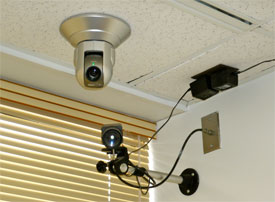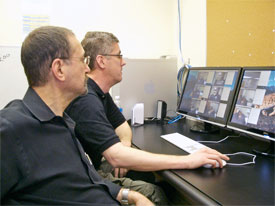National University of Health Sciences (NUHS) recently completed upgrades to the Training and Assessment Centers at both its Illinois and Florida campuses. Both centers will soon boast full digital capability, which broadens their usefulness and expands teaching and evaluation potential in the preclinical phase of the curriculum for DC, ND, MSAc and MSOM students.
Training and Assessment Center History
National was the first chiropractic educational institution to develop and implement a Training and Assessment Center in its clinic, beginning in 1990. The TAC provides special assessment/treatment rooms where students are recorded and evaluated as they encounter standardized patients or other simulated clinical challenges. Previously the students were taped on analog equipment, and the tapes used for later evaluation. With the tapes, student and instructor could watch how the student interacted with the patient and evaluate both diagnostic and relationship-building skills.
With the advent of digital recording equipment, VHS recordings have made way for digital video cameras, easy file sharing via Internet, and expanded potential for TAC capabilities and usefulness.
Upgrades Allow More Flexible Access to Digital Recordings
In Illinois, each of the 10 encounter rooms have now been equipped with a new digital camera capable of pan, tilt and zoom, all controlled from a central control room. A control room computer monitor can watch live-stream video from any camera angle in any and/or all rooms simultaneously.

New digital equipment in TAC encounter room
The camera in each room can be ‘preset’ so that ‘the push of a button’ in the control room shifts a given camera view from the interview table, to the examination table, to the treatment table, or several other presets at the instructors’ discretion. New microphones have also been installed so that audio pick-up is clearer. Zoom capability is sufficient to view a single mole or the tip of an acupuncture needle.
Recording to a digital file allows the student-patient interaction to be saved, copied and reviewed easily by the student and several instructors, or replayed for discussion via computer projection in the classroom. Faculty can now more easily monitor student performance from the control room during classes or examinations. Also, they can view the TAC encounters from their own offices either in real-time or as digital recordings. The recordings can be copied to USB flash drives in just a few minutes so that students can review the digital images from their own computers for self-evaluation.
Coming soon is a new intercom system for the existing TAC “People Mover” software. (This is the system that broadcasts messages such as “Please move to your next station, now.”) This is used when each room in the TAC has a different sequential exam scenario. With the new system, an instructor will be able to speak to a single room or a group of rooms, and students can respond or call directly to the control room without leaving the encounter-room.
Along with the upcoming changes will be the installation of three new cameras in the TAC hallways and the TAC Prep Room so that the TAC coordinator and instructors can monitor and control traffic effectively during exams and classes. Because these cameras will be in ‘public-access areas’, signs will be posted,”Notice, Video Surveillance in Use On These Premises!”
Florida Campus Upgrades
The Florida campus will soon have similar equipment in seven encounter-rooms. The new digital equipment will allow full  interactive capability between the Lombard and Florida TACs, so that Illinois faculty can evaluate student performance in Florida and vice versa.
interactive capability between the Lombard and Florida TACs, so that Illinois faculty can evaluate student performance in Florida and vice versa.
Ezra Cohen, DC, Robert Shiel, PhD, and TAC Coordinator MacLean Zehler directed the upgrade project with the technical expertise of the Director of Computer Services Kurt Faler and the assistance of Director of Facilities Tom Rohner. Thanks to this group’s diligence and years of planning and research, the university was able to install the new equipment for a fraction of the cost of commercial brand-named systems.
“With these upgrades, we expect greater inclusion of the TAC in classroom activities, laboratory examinations and Phase Exams,” says Zehler.




0 Comments